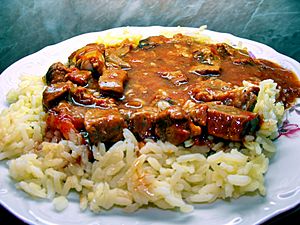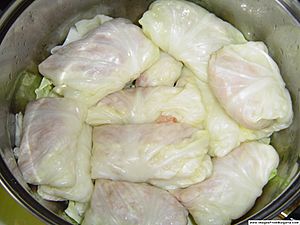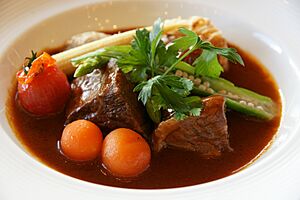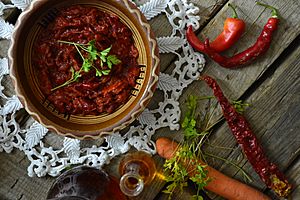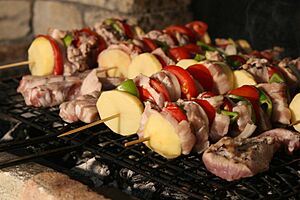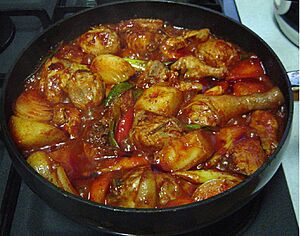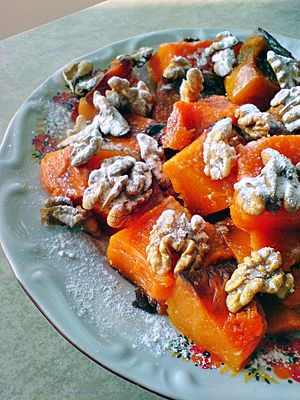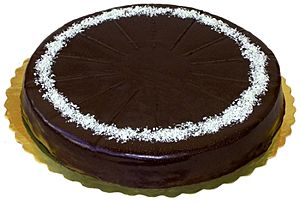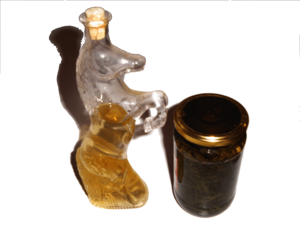Bulgarian cuisine facts for kids
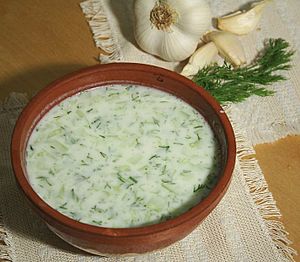
Bulgarian cuisine is the food style of Southeast Europe. It has many things in common with other Balkan cuisines. Bulgarian cooking is very diverse because of the country's climate. This climate is great for growing many different vegetables, herbs, and fruits. Besides local Bulgarian dishes, the food also shares many dishes with Persian, Turkish, and Greek cuisine.
Bulgarian meals often start with fresh salads. Dairy products are very important, especially yogurt. Bulgarians also enjoy wines and other drinks like rakia. You'll find many soups, like the cold tarator soup. Pastries are also popular, such as the layered filo dough pastry called banitsa, and different types of burek.
Main dishes are often stews, which can be vegetarian or made with lamb, goat meat, veal, chicken, or pork. Deep-frying is not common. However, grilling is very popular, especially for different kinds of sausages. Pork is often mixed with veal or lamb. Fish and chicken are also widely eaten. Veal is popular for grilled appetizers called meze. Bulgaria exports a lot of lamb, and people there eat a lot of it, especially in spring.
Bulgarians traditionally eat more yogurt (called kiselo mlyako, meaning "sour milk") than people in other parts of Europe. Bulgaria is famous for the Lactobacillus bulgaricus bacteria. This special microorganism helps make their unique yogurt.
Bulgarian cuisine shares many dishes with Middle Eastern cuisine. These include popular foods like moussaka, gyuvetch, kyufte, and baklava. A white cheese called "sirene" (сирене) is also very popular. It is similar to feta and is used in salads and many pastries.
Special holidays often have certain meals. For example, on Christmas Eve, people traditionally eat vegetarian stuffed peppers and cabbage leaf sarmi. New Year's Eve usually features cabbage dishes. On Nikulden (St. Nicholas Day, December 6), fish (often carp) is eaten. Gergyovden (St. George's Day, May 6) is usually celebrated with roast lamb.
Traditional Bulgarian Foods

Bulgarian Breakfasts
- Banitsa — A baked pastry made with layers of dough and filling. The most famous one has eggs, sirene cheese, and yogurt.
- Börek — Another favorite pastry, originally from Turkey.
- Princess with minced meat — An open-faced baked sandwich with minced meat, sometimes with yellow cheese.
- Mekitsi — Deep-fried dough pastry, often served with jam, honey, or sirene cheese.
- French toast — Bread dipped in egg and fried.
- Palachinki — Thin Bulgarian pancakes, sometimes rolled around a filling.
- Popara — A dish made from rusks or bread with tea, milk, or yogurt. Many Bulgarians remember this dish from their childhood.
Cold Meats
- Lukanka — A spicy salami made from minced beef and pork.
- Pastarma — A spicy dried beef sausage.
- Sujuk — A flat, cured, dark red sausage, popular in the Balkans.
Soups and Stews
- Tarator — A cold soup with cucumbers, garlic, yogurt, and dill.
- Vegetable soup — Made with fresh vegetables and potatoes.
- Bob chorba — A hot bean soup.
- Lentil soup — A hearty soup made with lentils.
- Chicken soup — Made with vermicelli, potatoes, and vegetables.
- Teleshko vareno — Boiled veal, potatoes, and vegetables in broth.
- Topcheta soup — A Bulgarian meatball soup thickened with egg yolks and yogurt.
- Shkembe chorba — A spicy soup made from tripe.
- Ghivetch — A spicy vegetable stew, sometimes with meat, often cooked in a clay pot.
Salads
- Ovcharska salata (shepherd's salad) — Similar to Shopska salad, but with added grated egg, mushrooms, and sometimes ham.
- Shopska salad — A common salad with chopped cucumbers, onions, peppers, and tomatoes, topped with white cheese.
- Snezhanka ("Snow White salad") — Chopped cucumbers mixed with yogurt, dill, garlic, and often walnuts.
- Turshiya — Pickled vegetables like celery, beets, cauliflower, and cabbage. It's popular in winter.
Sauces and Appetizers
- Lyutenitsa — A purée of tomatoes, red peppers, and carrots. It's often served on bread with white cheese.
- Kyopulu — Roasted eggplant and bell peppers, mashed with parsley and garlic.
- Sirene pane — Breaded Bulgarian white brine cheese bites.
- Kashkaval pane — Breaded kashkaval cheese bites.
Skara (Grill)
- Kyufte — Meatballs made from minced pork, seasoned and shaped into a flat ball.
- Kebapche — Similar to meatballs, but seasoned with cumin and shaped like a stick.
- Shishcheta — Marinated pieces of chicken or pork and vegetables on a skewer.
- Meshana skara — A mixed grill plate that includes kebapche, kyufte, shishche, and a type of sausage.
- Cheverme — A whole animal (like a pig or lamb) cooked slowly on an open fire for many hours. This is for big celebrations.
Main Dishes
- Ghivetch — A hearty stew.
- Sarma — Stuffed cabbage or vine leaves.
- Kavarma — A stew often made with meat and vegetables.
- Mish Mash — A popular summer dish with tomatoes, peppers, onion, white cheese, and eggs.
- Pilaf — Rice cooked with chopped meat, vegetables, or mussels.
- Moussaka — A baked dish with layers of potatoes, minced meat, and a creamy topping.
- Stuffed courgettes — Zucchini filled with a mixture.
- Pulneni chushki — Bulgarian stuffed bell peppers.
- Roasted Chicken with Potatoes — A simple and popular meal.
- Pork with Cabbage — A common stew.
- Meatloaf 'Rulo "Stephanie"' — A meatloaf often filled with eggs.
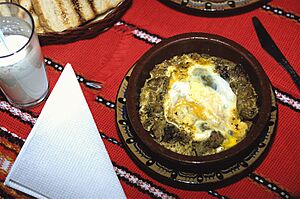
Breads and Pastries
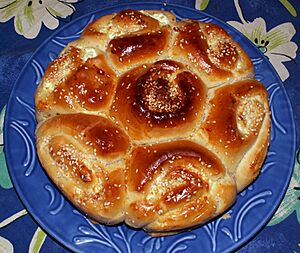
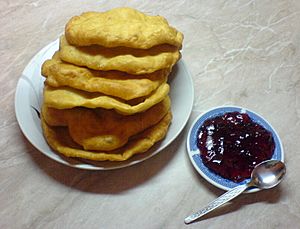
- Pita — A type of flatbread.
- Pogača — A special ritual bread.
- Banitsa — The most popular pastry in Bulgaria, with many different kinds.
- Tikvenik — A type of Banitsa made with pumpkins.
- Zelnik — Banitsa with white cheese and vegetables like cabbage or spinach.
- Baklava — A sweet, layered pastry.
- Parlenki — Flatbreads, often grilled.
- Mekitsi — Deep-fried dough made with yogurt and eggs.
- Palachinki — A type of crêpe (thin pancake).
- Kozunak — A sweet bread, often eaten during Easter.
Dairy Products
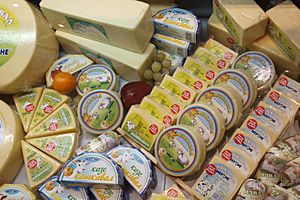
Bulgaria has a strong tradition of using milk and dairy products. A special bacteria called Lactobacillus bulgaricus is even named after Bulgaria. It gives many Bulgarian cheeses and fermented foods their unique taste.
- Sirene — A soft, salty white cheese used in many Bulgarian dishes.
- Kashkaval — A hard yellow cheese, often used in appetizers. Kashkaval Vitosha is made from cow's milk, and Kashkaval Balkan from ewe's milk.
- Kiselo mlyako — This means "sour milk" and is the Bulgarian word for yogurt. It's used in many dishes.
- Katak — A traditional fermented curd or yogurt-like product.
Sweets
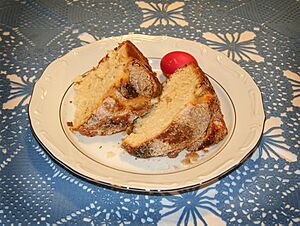
The word Halva is used for several sweet desserts from the Middle East. Tahini halva, made from sunflower or sesame seeds, is the most popular type.
- Baked Pumpkin (Печена тиква) — Often served with walnuts.
- Baklava — A sweet, layered pastry with nuts and syrup.
- Kadaif — A dessert made with thin noodle-like pastry.
- Tolumbi — Fried choux pastry cakes soaked in sweet syrup.
- Garash cake — A famous Bulgarian chocolate cake.
- Katmi with jam or honey — A type of pancake often served sweet.
- Keks — Similar to a marble cake.
- Kompot — A sweet fruit drink with pieces of fruit.
- Kozunak — A sweet bread, especially for holidays.
- Milk with Rice — A creamy rice pudding.
- Tikvenik — A sweet pumpkin pastry.
Spices and Herbs
- Summer savory (Chubritsa) — A very common herb in Bulgarian cooking.
- Spearmint (Djodjen) — Used in many dishes.
- Sharena sol — A colorful mix of salt and spices.
Other Staples
- Yoghurt ("Kiselo Mlyako") — A key ingredient in many dishes.
- Honey ("Med") — Used in desserts and with breakfast foods.
Traditional Bulgarian Drinks
Wine
- Mavrud
- Pamid
- Gamza
- Melnik wine
- Dimyat
- Misket
- Muskat
- Rubin
Strong Alcoholic Drinks
- Rakia — A strong fruit brandy, very popular.
- Slivovitsa — Rakia made from plums.
- Gyulova Rakia — Rakia made from roses.
- Mastika — A strong anise-flavored drink.
- Menta — A mint-flavored liqueur.
Beer
- Ariana
- Astika
- Kamenitza
- Pirinsko
- Zagorka
Fermented Drinks
Hot Drinks
- Tea — Often made with local herbs, rose, or fruits.
- Greyana Rakiya — Boiled rakia, a warm alcoholic drink for winter.
- Greyano Vino — Warm spiced wine, also for winter.
|
See also
 In Spanish: Gastronomía de Bulgaria para niños
In Spanish: Gastronomía de Bulgaria para niños


